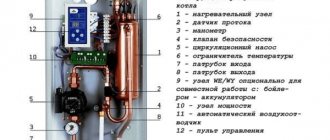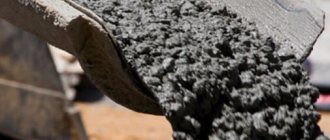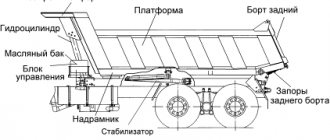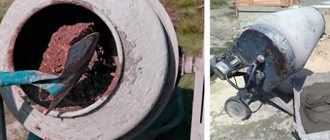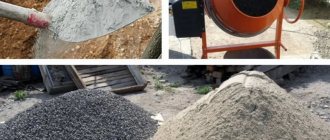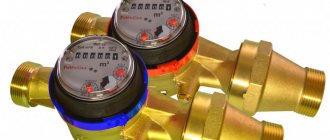How do concrete mixers work?
These devices are designed to mix and deliver liquid solution to clients. They contain the following structural elements:
- A drum containing a liquid solution. The power of the concrete mixer depends on the size and type of container.
- The bed is the basis of the structure. All other nodes are located on it. The frame consists of pipes and profiles. Some brands of concrete mixers have a chassis for ease of use.
- Parts used to mix the solution. Blades or augers can be used for this purpose.
- The engine and transmission that rotate the mixer. It can be gasoline or electric.
- A control unit is used to turn on, turn off or change the rotation speed of the concrete mixer.
These nodes are present in all such devices.
Preparation of the solution Source www.rmnt.ru
Classification
Concrete mixers can have different designs. They are classified according to several criteria.
By mixing method
In gravity mixers, the internal screw is stationary, and the container with the solution rotates. Under the influence of gravity, the solution falls from the walls, gradually mixing. By changing the inclination of the tank, you can increase or decrease it, controlling the intensity of work.
These concrete mixers can use various mixing methods:
- Inside the drum there is a gear ring located around the entire circumference. A cast iron crown is considered less expensive, but it produces a lot of noise during operation. The plastic crown does not have this drawback. The most expensive option is to use one that is made of steel. In this case, the solution is not protected from the ingress of random debris.
- The gear method is considered the most reliable. Its repair is more complex compared to the coronal one.
Cast iron gear rim Source prom.st
The advantages of this kind of mixers are:
- Due to the fact that relatively little power is required for operation, energy consumption during operation is reduced.
- These models usually have wheels, which makes it easy to move the concrete mixer to the desired location.
However, this type of device has disadvantages:
- The tank needs to be cleaned and washed after each use, which is a labor-intensive procedure. If you do not do this, then gradually a thick layer of dried mortar will be deposited inside, which will complicate work in the future.
- Sometimes the solution splashes out while stirring.
- It is difficult to scoop out the prepared solution, so it is usually first poured from the reservoir into a special trough.
For operation, electric motors are used that require connection to a supply voltage of 380 volts. This is not convenient for all builders.
Preparing for unloading Source veralline.com
Forced action devices include a stationary reservoir and a rotating mixing part. Such devices are convenient in cases where a little water is needed or when using special additives.
Typically, such concrete mixers are large in size, and therefore they are not profitable to use where the volume of work is small.
Such devices are characterized by the following advantages:
- They provide high-quality mixing of the solution.
- Extraction of the prepared solution can be dosed.
In such devices, the following problem can sometimes occur. If the solution is not sufficiently cleaned, it may contain stones or other debris that can jam the rotating part, getting between it and the mixer body.
Forced action concrete mixer Source www.prostanki.com
By continuity of action
Some devices can mix continuously. This helps maintain the quality of the solution for as long as necessary, but requires a lot of energy.
There are concrete mixers that periodically turn off during operation. This reduces energy consumption. Typically, cyclic mixers are used in private construction. When thinking about how to choose a concrete mixer for your home, you need to consider devices of this type.
By type of energy used
A concrete mixer requires energy to perform mixing.
Mixer powered by an electric motor Source domostroi26.ru
It may have the following sources:
- In some cases, a manual drive is used. The work requires significant labor costs. However, such mixers have the advantage of high autonomy. The disadvantage is the small volume of the solution being processed.
- A hydraulic drive can be used. In order to ensure rotation, it is necessary to provide a high-pressure fluid supply. Additional equipment is required during operation. Such mixers are used in industrial settings.
- Some concrete mixers rotate using a pneumatic drive. Since this is ensured by the use of special devices, they are usually used for industrial construction sites.
- If a diesel or gasoline engine is used, this allows you to combine power and autonomy. However, during operation, such mixers make loud noise and produce exhaust fumes. The operation requires purchasing fuel on a large scale.
Powered by a diesel engine Source sc01.alicdn.com
- Electric motors are the most popular. They combine high power and relatively economical consumption of resources. They are used for mixers of various capacities: from 30 to thousands of liters.
Of all of these, electric motors have the most universal application. To know how to choose a concrete mixer, you need to determine which motor is more profitable to use.
See also: Catalog of companies that specialize in equipping foundations and installing stoves and fireplaces.
How to choose a concrete mixer: two operating principles and their advantages
All modern professional and household concrete mixers, according to the principle of their operation and the method of mixing mixtures, are divided into two types: gravitational and forced. Both types of concrete mixers cope well with the tasks assigned to them and differ exclusively in design and, as a result, in capabilities.
- Forced action concrete mixers. The main difference from similar gravity-type equipment is a stationary container for mixing the solution. Such a device can rather be called a powerful mixer, in which the solution is prepared using movable blades driven by a powerful electric drive. Such devices have one significant drawback - they are not able to work with coarse filler. That is why in most cases they are combined with concrete pumps, which are also not able to pump coarse concrete over distances. In addition, due to this design, forced-action concrete mixers are not economical enough in terms of energy consumption - in order to reduce the load on the engine and thereby increase its service life, they are equipped with obviously powerful motors. There are also units separate from the concrete pump that are used for domestic and professional purposes - they are mainly used for mixing light plaster solutions or floor screed.
- Gravity concrete mixers are a familiar design for everyone, which is popularly called a “pear”. Its operating principle is based on the rotation of a drum with fixed blades, which raise the solution to a height, after which, under the influence of gravity, it falls down, mixing in a similar way. In this design of a concrete mixer, the filler fraction does not matter at all - this concrete mixer is capable of mixing both heavy and light concrete. The answer to the question of which concrete mixer to choose for private construction is simple - gravity. In any case, you will have to mix all types of mortars - you will have to prepare heavy concrete for the foundation and light mortar for plaster or floor screed.
We advise you to study - Filled floors - photos and videos, a selection of original solutions
Delivery
Concrete mixers are a convenient way to prepare cement mortar. For some chassis-mounted varieties, there is another application: with their help, industrial companies deliver the solution to customers, maintaining it in a liquid state. The width of the Kamaz concrete mixer allows you to deliver a significant amount of mortar in one trip.
Of course, you can make the solution yourself, but you need to spend some time on it and you cannot guarantee the high quality of the concrete obtained in this way.
Concrete is made this way without a concrete mixer Source yandex.net
It is convenient to use the services of specialized companies that will not only prepare the cement mixture of the required brand, but also deliver the liquid mixture, ready for use, directly to the construction site.
Receiving such services has its positive aspects:
- The supply of solution for preparing concrete occurs quickly and efficiently. This is beneficial both for the construction of private houses and for large construction projects.
- With the help of mixers, delivery can occur over long distances without loss of quality.
- When providing services, it is usually provided not only for the unloading of manufactured products, but also for the direct pouring of cement mortar.
This sales method allows the client to order exactly the volume of solution that he needs.
Selecting a concrete mixer
The following are some tips on how to choose a concrete mixer for your home and garden:
- It is necessary to determine what volume the drum should have: up to 100, 100-150, 150-300, more than 300 liters.
- The thickness of the drum walls matters. If the mixer is purchased for private construction, then 2 mm is sufficient for solid walls, and 4 mm for welded seams.
- When determining the required volume, you need to take into account. That optimal performance is achieved not when fully loaded, but when two-thirds full. In this case, the quality of the mixture will be higher.
- For private construction, it is preferable to purchase a device that uses a crown. It is advisable to buy those that use a part made of polymers.
- The device power of 700 W is most suitable for private low-rise construction.
Characteristics of concrete mixers
Drum size
First of all, you need to decide on the size of the drum. The subtlety in choosing the volume of the mixer lies in its size, and it does not always coincide with the working volume of the finished solution. This happens due to design features. Therefore, when choosing, we focus on a larger volume than you require. For example, if we are talking about small construction sites (a one-story or two-story house in the country), then you can use household concrete mixers from 45 liters to 150 liters.
Power
High indicators of this characteristic do not mean at all that the concrete mixer is capable of producing a large amount of solution. Rather, power affects the ability of the device to better mix heavy and large fractions of concrete. As a rule, it all depends on the volume of equipment. The larger the drum, the more powerful the engine must be. For a drum up to 150 liters, a 700 watt engine is quite suitable. We must not forget that the less powerful the engine, the less electricity it consumes.
Operating mode
If you need to stop the drum from time to time and then start it again, then the question of which concrete mixer to choose resolves itself. In this case, you will need a device that can operate periodically. If a continuous concrete mixer is used, then its technical characteristics will not allow stopping the process of mixing the solution.
Material from which the drum is made
Most models are made of steel. It all depends on its thickness. It must be borne in mind that the solution has the ability to corrode the walls of the drum. Therefore, if you count on the durability of the device, then choose a wall thickness of at least 1-2 mm.
Motor protection
The concrete mixer engine must be protected by a special casing or located in a metal box. Because you often have to work outdoors.
Decide for yourself what time of year you are going to do construction. Most models are designed for the spring-summer-autumn period. It is not recommended to do masonry and pouring in winter, because the quality of concrete deteriorates sharply. However, especially for our harsh climate in Russia, the production of special concrete mixers has been launched, which allow pouring in winter, preventing a decrease in the quality and properties of concrete produced at low temperatures.
We advise you to study - Screw piles: characteristics, advantages and disadvantages
Watch the video on the Internet, it will help you decide on the choice of concrete mixer.
The best are made in Germany, Italy and France. Good models are produced by Croatian and Polish manufacturers. Foreign tools are more convenient to use, as they are equipped with wheels or carts for transportation.
Although, in terms of performance and service life, domestic models compare favorably with quality. And the cost of our products is much lower.
Rating
If you plan to purchase a mixer for working at home, it makes sense to pay attention to the following rating of concrete mixers, which includes popular and high-quality models:
- RedVerg RD-CM 63
It has a drum volume of 63 liters. It is suitable for building a summer house. This concrete mixer can be purchased at an affordable price. She has a high-quality polymer crown. Disadvantages are loud noise,
- Concrete mixer Lebedyan RN-200
Suitable not only for home use, but also for professional construction work. The drum volume is 200 liters. Immediately after the end of the cement mortar preparation cycle, you can start the next one. A powerful electric motor is used. A batch of solution can be prepared in two minutes.
Concrete mixer Lebedyan Source i1.ytimg.com
- Model SBR-100
Has a cast iron crown. The solution preparation time is one and a half minutes. This concrete mixer operates from a 220 V network. Rotation is transmitted from the motor using a soft belt. If operated in a state of overload, it may wobble greatly.
There are various types of concrete mixers on sale, among which the client can always choose the most suitable one.
Briefly about the main thing
There are many types of concrete mixers. Some of them are intended for industrial, others for private construction.
Depending on the device, the tank in which the cement mortar is mixed has its own characteristics that affect its performance.
The actual volume of concrete supplied in automixers may not correspond to that stated in the invoice. Usually, this is the result of an oversight at some stage of loading, so it is best to control the entire process yourself.
You can control the amount of concrete by comparing the weight of the machine before and after loading, measuring the unloading time, plus making sure that the concrete is poured into a clean mixer.
Ratings 0
A little theory
First, let's figure out what kinds of concrete mixers there are, and on what principles their work is based.
Classification of mixers
The most common division of concrete mixers into types is as follows.
According to the cyclicity of work:
Continuous concrete mixers. They are constantly loading components and unloading the finished mixture. Such mixers are most often used in production or on large construction sites.
Concrete mixing plant using a continuous mixer
Cyclic mixers. As is clear from the name, the work proceeds in cycles - loading, mixing, unloading concrete. They are used for small volumes of work. With a few exceptions, they are used in the household.
Powerful cyclic concrete mixer trucks
Based on the operating principle:
- Gravitational - mixing occurs mainly due to the mixing of components falling from a height. They are the most compact and simple in design. The only drawback is that the mixing time for light mixtures is increased.
- Forced action - special blades and augers are used for mixing. Such mixers quickly and efficiently mix any mixture, but they are larger in size and more complex in design.
By drive type:
- With manual drive. As a rule, homemade devices. We will describe the assembly of such a mixer below.
- Electrically driven. The most common.
- With an internal combustion engine. They have increased dimensions and weight, but do not require power supply.
- With external drive. Usually connected to the power take-off shaft of vehicles.
By mobility:
- Stationary.
- Mobile.
Now a little more about the design of the most common gravity and forced concrete mixers. By the way, a homemade faucet from a washing machine is very popular on the Internet, but due to its small volume, this is a completely frivolous option - it’s faster to mix a bucket of concrete with a shovel or even a trowel.
Gravity concrete mixers
Trailed Gravity Mixer
The gravity kneading device consists of the following parts:
- A drum (pear) with blades welded on the inner surface.
- The drive that rotates it.
- Frames with a rotation mechanism in the direction perpendicular to the axis of its rotation.
To load, the unit is installed in a position where its axis is vertical. After this, it tilts closer to the horizontal and is put into rotation.
Some of the components are captured by the blades and rise up, from where they fall into the rest of the mixture, due to which mixing occurs. To unload, the rotating device is tilted even lower.
Forced concrete mixers
Large volume mixer
There are also few details in it:
- The container in which mixing takes place.
- Drive unit.
- Unloading device (usually a hatch).
- One or more working bodies. These are usually rotating blades on an axis. There are options with augers (Archimedes screws).
The principle of operation is clear from the name. The loaded components are moved inside the working bodies due to which mixing occurs.
Now, after a short theoretical excursion, we will consider specific designs of homemade mixers.
